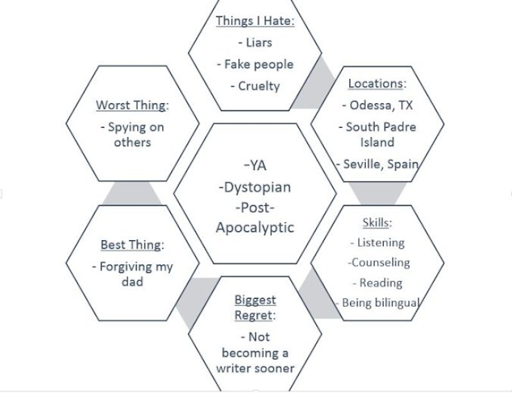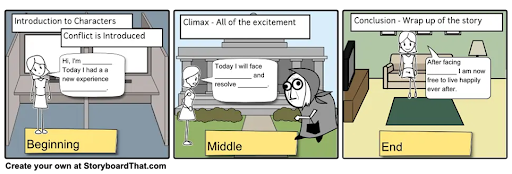Education
Last month we talked about the beginning of a story: the first sentence, the first chapter, and everything that is important in hooking your readers in. This month, we'll continue with the middle. The middle is the meat of the story; the part your protagonist has the muddle through in order to get to that satisfying ending. But if you want your reader to actually reach that brilliant ending you've come up with, you'll have to make sure they don't get bored and drop out in the middle. It's difficult to write a middle that doesn't sag, as shown in the picture below, but we'll make it as easy as possible for you.

The one thing that's most often said about the middle of a novel is that it needs to give the protagonist trouble. This is all too true, and we'll get to it more later on in this article. But there's something we want to focus on first: the exact middle point of the story.
Disclaimer: the exact middle of the story is not necessarily the exact middle of the book, wordcount-wise. Things are never that straightforward in writing.
The exact middle point of your story isn't a full scene. It's more of a moment within a scene. It's a mirror moment, in which the protagonist finds themselves changing, or having changes, in a significant way. It has them ask themselves who they are, what they've become, and who they're supposed to be.
If done well, this middle point will clarify the entire book for the reader. They'll understand exactly what the protagonist is working so hard towards (and will have the rest of the story to achieve), and they'll understand why the first half of the book was necessary to get the protagonist to this point.
An example. Let's say we have a romance novel. The entire middle will consist of the protagonist and their love interest slowly getting together while something is keeping them apart. The exact midpoint might be when the protagonist realizes that what they've been trying to get from life isn't actually what they need; what they need is the love interest, who they've been pushing away throughout the entire first half of the book – queue the rest of the book, where they'll to themselves and the world that they are worthy of the love interest.
Writer James Scott Bell thinks this middle point is actually so important to the story, that you might just want to start writing here. You come up with the middle, then the beginning and end, and only when you have all that can you start writing. He's built a whole new writing method around this idea.

Many experts believe that the middle of a novel is where your protagonist has to fight their way through all the trouble you, as the author, throw at them. You should create problem after problem for them, ramping the tension and consequences up until they reach a maximum; the climax. Make your protagonist struggle so that he can develop as a person and eventually become the person they're supposed to be.
The picture above visualizes this really well. You start with the exposition (the beginning, the hook, whatever you want to call it). Everything after that, up until the climax, is the middle. As the picture shows, the rising action isn't a simple straight line. The action, and the tension, goes up and down. It consists of a struggle between two opposing characters or forces.
There are many different ways to keep the middle part of your story from sagging and becoming boring. We'll discuss a few of the major ones here.
Our first tip: break the goal down into manageable parts. Your protagonist has a major, overarching goal to reach throughout the novel. If you've plotted out the ending (which we highly recommend doing), you'll know what this goal is. If you have your goal, you can start breaking it down into smaller parts. You know where your character starts, and you know where he ends. Figure out what needs to happen in between for him to finally reach that big goal.
Raise the stakes as you go. Every new challenge should be a little harder than the step before. Also, the challenges should be different types of obstacles: physical, mental, and emotional. The more diverse scenes you write, the more you'll be able to develop your character into a rounded, three-dimensional person.

Subplots. Subplots are the most important tool in your belt to get through the middle of your story. Subplots will aim to give your protagonist the skills or knowledge or even side characters they need to achieve the goal of the story. Therefore, figure this out first: what is it they need to achieve that goal, and how can you give it to them throughout the middle? Remember not to make it too easy on them.
Subplots can also introduce information that adds urgency to the story; someone might reveal a secondary goal of the antagonist, making it even more important to stop them.
The figure above might look a little confusing at first, but it's an example of an author (rmcalzada) who mapped out the subplots to work with throughout their story. The main theme of the story, as you can see in the middle of the figure, is that it's a YA dystopian. Around it, you'll see all the things the protagonist needs to achieve their final goal (skills, locations), or the things that might stand in their way (worst thing they have to do to survive, biggest regret, etc.).
A final thing to remember about subplots is that they should always tie in with the main plot eventually. If it doesn't, it's not a good subplot, and you should leave it out. A scene or subplot might feel like sideways action, taking the protagonist away from the main goal at first, but in the end, they should gain something that helps them tackle the main issue.

Bringing in new, minor characters will also help spice up your middle. They could produce tension and suspense, especially when the protagonist doesn't quite trust or understand them. Minor characters could also possess knowledge or skills that turn out to be crucial for the protagonist's progress towards the climax. Additionally, a minor character might simply help your protagonist understand something about themselves or draw something out that they didn't realize they could do before, like confronting someone or forgiving themselves for something. Introducing new characters will enable new possible conflicts between your characters.
Finally, a more practical tip: you might tackle writing the middle by making a list of 50 to 80 possible scenes (depending on the length of your story). About half of those scenes should be in the middle of the book. Look at it like a puzzle: which of those pieces fit together to create a beautiful picture, and in which order? Remember, the stakes should be raised higher and higher.
We hope this article has helped you in figuring out how to write the middle of your story. If you're interested in practicing your craft, don't hesitate to check out our Creative Dreams Writing Club, which can be found on our page. All the best in your writing journey!
Naomi - NDeMeer
Team Of Dreams

Bạn đang đọc truyện trên: Truyen247.Pro